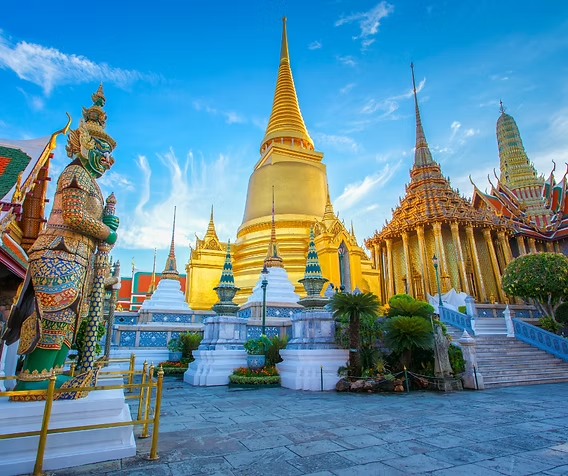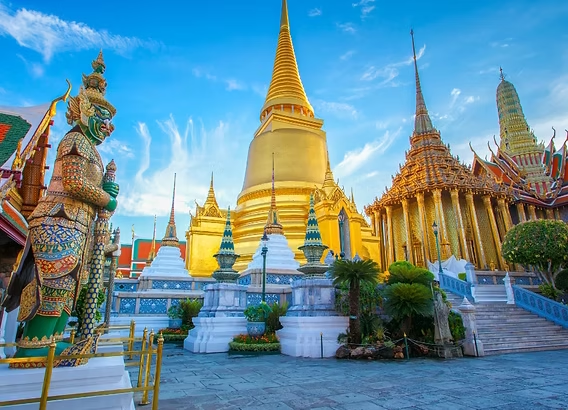
Bangkok, the pulsating capital of Thailand, is a city of contrasts and harmonies—a place where ancient traditions meet modern life in a vibrant cultural tapestry. While glass skyscrapers and buzzing tuk-tuks dominate the city’s skyline and streets, at its heart lies a deep reverence for history, spirituality, and food. Nowhere is this blend more vivid than in the coexistence of Bangkok’s grand temples and its world-renowned street food scene.
A trip to Bangkok isn’t just a vacation—it’s a sensory experience. The gleaming spires of Buddhist temples and the heady aroma of sizzling street food are integral parts of the city’s identity. From sunrise prayers at golden pagodas to midnight feasts in night markets, Bangkok offers an unforgettable adventure that engages the body, mind, and spirit.
The Spiritual Splendor of Bangkok’s Grand Temples
Thailand is a predominantly Buddhist country, and Bangkok, its capital, is home to some of the most revered temples (called wats) in Southeast Asia. These temples are not just places of worship; they are also centers of art, architecture, history, and cultural continuity.
Wat Phra Kaew and The Grand Palace
No visit to Bangkok is complete without witnessing the grandeur of Wat Phra Kaew, or the Temple of the Emerald Buddha, nestled within the Grand Palace complex. This temple is considered the most sacred in Thailand and houses the revered Emerald Buddha, a statue carved from a single block of green jade.
The Grand Palace itself is a masterpiece of traditional Thai architecture, with its golden stupas, intricate carvings, and vividly painted murals. Built in 1782, it served as the royal residence for generations of Thai kings. Today, while no longer a royal dwelling, it remains a symbol of Thailand’s rich cultural heritage and royal legacy.
Visiting Wat Phra Kaew is an awe-inspiring experience—glittering mosaics, ornate rooftops, and tranquil courtyards create a sense of divine serenity. The temple grounds reflect centuries of devotion, craftsmanship, and Thai spiritual identity.
Wat Arun – The Temple of Dawn
Located on the west bank of the Chao Phraya River, Wat Arun, or the Temple of Dawn, is one of Bangkok’s most iconic landmarks. Its central prang (Khmer-style tower) rises 70 meters high, beautifully decorated with porcelain shards and seashells that shimmer in the sunlight.
Wat Arun is best visited either at sunrise or sunset when the temple glows with ethereal light. Climbing the steep steps of the central prang rewards visitors with panoramic views of the river and the city. It’s a spiritual haven and a photographic treasure alike.
Wat Pho – Home of the Reclining Buddha
Just a short walk from the Grand Palace is Wat Pho, famous for its 46-meter-long reclining Buddha covered in gold leaf. The statue represents the Buddha entering Nirvana and is a marvel of religious artistry.
Wat Pho is also the birthplace of traditional Thai massage, and the temple complex houses a school for Thai medicine and massage. After admiring the statue and temple architecture, many visitors choose to relax with a traditional Thai massage—an experience that blends spirituality and physical healing.
Wat Saket – The Golden Mount
Rising above Bangkok’s old town, Wat Saket sits atop a man-made hill known as the Golden Mount. Its gleaming golden chedi (stupa) houses relics of the Buddha, and the temple offers peaceful respite from the city’s hustle and bustle.
To reach the top, visitors climb a spiraling staircase flanked by bells, gongs, and trees. The summit offers a stunning 360-degree view of Bangkok and a peaceful place for contemplation.
Bangkok’s Street Food: A Culinary Wonderland
If Bangkok’s temples feed the soul, its street food feeds the body—and does so spectacularly. Recognized globally as one of the world’s greatest food cities, Bangkok’s culinary scene thrives not in fine-dining establishments but on the sidewalks, in alleyways, and at chaotic night markets.
From dawn till well past midnight, the city buzzes with food vendors cooking up Thai delicacies that are rich in flavor, history, and creativity. The affordability, accessibility, and sheer variety of dishes make street food in Bangkok a must-experience part of any visit.
Where to Find the Best Street Food
Street food in Bangkok is everywhere, but some areas have become legendary for their culinary offerings:
- Yaowarat (Chinatown) – A haven for adventurous eaters. From grilled seafood to bird’s nest soup, Chinatown offers a fusion of Thai and Chinese flavors in a buzzing night market atmosphere.
- Ratchawat and Sriyan Markets – Located in Dusit, these markets offer more traditional and local street food, with less tourist traffic and a more authentic vibe.
- Victory Monument – A transportation hub surrounded by food stalls serving up everything from noodles to fried snacks.
- Chatuchak Weekend Market – A sprawling market where shopping meets eating. Mango sticky rice, coconut ice cream, grilled meats—you’ll find it all here.
- Khao San Road – While more tourist-oriented, it’s still a great place to sample pad thai, banana pancakes, and even fried insects.
Iconic Street Food Dishes to Try
1. Pad Thai
This famous Thai stir-fried noodle dish is a staple of Bangkok’s street food scene. It’s made with rice noodles, eggs, tofu or shrimp, tamarind paste, fish sauce, and peanuts. It’s sweet, sour, salty, and nutty all in one bite.
2. Som Tum (Green Papaya Salad)
Spicy, sour, and refreshingly crunchy, Som Tum is made from shredded green papaya, tomatoes, chili, lime, garlic, and fish sauce. It’s a zesty favorite that pairs well with sticky rice or grilled meats.
3. Moo Ping (Grilled Pork Skewers)
Juicy pork marinated in sweet soy sauce and grilled over charcoal, often served with sticky rice. This is one of the most popular street snacks and perfect for eating on the go.
4. Tom Yum Goong
This spicy and sour shrimp soup is a Thai culinary masterpiece. Lemongrass, kaffir lime leaves, galangal, chili, and lime juice create a bold broth that’s as aromatic as it is delicious.
5. Khao Man Gai (Chicken and Rice)
Inspired by Hainanese cuisine, this dish features poached chicken served over fragrant rice with a side of garlic-ginger sauce and a light chicken broth.
6. Kanom Krok
These small coconut pancakes are crisp on the outside and soft on the inside. Made with rice flour and coconut milk, they are often sold from mobile griddles in morning markets.
7. Mango Sticky Rice
A beloved dessert combining sweet mangoes, glutinous rice, and coconut milk. It’s a seasonal treat and a quintessential Thai ending to any meal.
Michelin-Starred Street Food
In 2018, Bangkok’s street food culture gained international acclaim when Jay Fai, a street-side chef known for her crab omelets and wok-fried dishes, received a Michelin star. Despite the humble setting, her food is praised for its flavor, technique, and premium ingredients.
This recognition placed Bangkok’s street food scene on the global culinary map and reaffirmed the idea that world-class cuisine can be found under a tarpaulin tent or beside a busy road.
Blending Temples and Tastes: The Ideal Bangkok Itinerary
One of Bangkok’s greatest charms is how easy it is to combine spiritual exploration with gastronomic adventure. Here’s a suggested one-day itinerary that lets you enjoy the best of both worlds:
Morning
- Start your day with a visit to Wat Phra Kaew and the Grand Palace.
- Walk over to Wat Pho and admire the Reclining Buddha.
- Enjoy a traditional Thai massage at the temple’s massage school.
Lunch
- Cross the Chao Phraya River by ferry and grab lunch near Wat Arun—a local restaurant serving Pad Thai or curry will do the trick.
- Explore Wat Arun and climb the central prang for stunning views.
Afternoon
- Head to Wat Saket (Golden Mount) for a peaceful climb and scenic sunset.
- Stroll through old Bangkok and maybe visit a local market for snacks.
Evening
- Head to Yaowarat Road (Chinatown) for a night of street food indulgence. Try grilled squid, dumplings, fresh pomegranate juice, or coconut ice cream.
- If you’re still hungry (you probably will be), finish with a mango sticky rice from a dessert cart.
Practical Tips for Exploring Bangkok
- Dress modestly when visiting temples: shoulders and knees must be covered. Some temples provide rental shawls or sarongs.
- Hydrate regularly: Bangkok’s heat and humidity can be intense, especially when exploring on foot.
- Use public transportation like the BTS Skytrain and MRT for faster travel, especially during rush hour.
- Carry small cash, as most food stalls and smaller temples do not accept cards.
- Be cautious but adventurous with street food. Eat at busy stalls with high turnover for the freshest fare.
Conclusion: A City that Nourishes Body and Soul
Bangkok is a city that exists in harmony between the sacred and the sensual. Its majestic temples invite you to slow down, reflect, and connect with centuries-old traditions. Its street food, on the other hand, celebrates the joy of eating and the creativity of everyday life.
Whether you’re gazing up at the golden chedi of Wat Pho or savoring the crunch of moo ping at a night market, you’re experiencing the essence of Bangkok—a city where the divine and the delicious coexist effortlessly.
To truly discover Bangkok is to open yourself to contrast and complexity, where spirituality is served with a side of spice, and every corner holds a story, a flavor, or a spark of wonder. Come for the temples, stay for the food—and leave with a heart full of memories.




